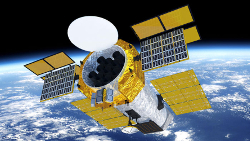 HEAPOW: More Room in Space (2018 Apr 02)
HEAPOW: More Room in Space (2018 Apr 02)
Observation of the X-ray emitting objects in the Universe can only be done above the opaque barrier of earth's atmosphere. Because of this, X-ray observations have mostly relied on X-ray satellite observatories. Space-based X-ray observatories date back to 1959 with the launch of the Vanguard 3 satellite (designed to study X-ray emission from the Sun). Contributions from X-ray observatories like the Einstein Observatory, ROSAT, the Chandra X-ray Observatory, XMM-Newton, and many others have expanded our understanding of cosmic high-energy processes and phenomenon. The majority of these missions have been designed, launched and operated by the US, European and Russian space agencies. Now China is playing an increasingly larger role in the X-ray astrophysics club. China's first X-ray astronomy mission, the Hard-X-ray Modulation Telescope, was launched last June. China's Academy of Sciences also has plans for additional space-based high-energy astrophysics facilities for launch in the near future. China's Einstein Probe (planned for launch in 2021) is a small satellite using "lobster-eye" optics to monitor wide areas of the sky for transient events (like magnetically-driven flares from stars, accretion-driven flares from black holes and neutron stars, mergers of compact objects, and other extreme events) and quickly announce these events to astronomers on the ground for rapid followup observations. Pictured above is China's enhanced X-ray Timing and Polarimetry satellite, a mission designed to perform sensitive measurements of both the spectrum and polarization state of X-ray emission from neutron stars and other objects. The eXTP satellite would be China's most expensive and ambitious X-ray mission to date, involving contributions from an international team of more than 200 high-energy astrophysicists from more than 20 countries. If approved for development, eXTP should be launched in 2025.
Science: China unveils plans for x-ray satellite to probe most violent corners of the universe
| << Previous HEAPOW | High Energy Astrophysics Picture of the Week | Next HEAPOW >> |